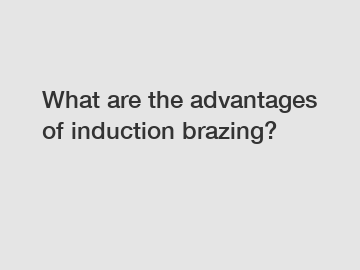Jan. 14, 2024
Machinery
Chaochang Product Page
What are the advantages of induction brazing?
Induction brazing is a highly efficient and widely used method for joining metal components. Its advantages are numerous and have made it a preferred choice for many industries. The key advantages of induction brazing are the precise control over heat distribution, reduced cycle times, improved quality and reliability, and the ability to join dissimilar materials.

The precise control over heat distribution is one of the most significant advantages of induction brazing. Unlike traditional brazing techniques, where the heat is generated externally and then transferred to the workpiece, induction brazing uses an electromagnetic field to generate heat directly in the workpiece. This allows for pinpoint accuracy in heating specific areas, minimizing the risk of overheating or damaging adjacent components. The high level of control ensures consistent brazing results and reduces the need for costly rework or repairs.
Reduced cycle times are another major advantage of induction brazing. The speed at which induction heating can be achieved is much faster than other heating methods. The efficiency of the process not only saves time but also reduces energy consumption, making it a cost-effective choice for manufacturers. Additionally, the fast heating and cooling cycles enable high production rates, increasing overall productivity.
Improved quality and reliability are inherent to induction brazing. The localized heating provided by induction technology minimizes distortion and warping of the workpiece, ensuring accurate alignment and fitment. The controlled and uniform heating produces strong and consistent joints, eliminating the risk of weak or unreliable connections. The reliability of induction brazing is crucial in industries where safety and performance are paramount, such as automotive and aerospace.
The ability to join dissimilar materials is another advantageous feature of induction brazing. The process allows for the joining of various combinations of metals, including copper, stainless steel, aluminum, and brass. This flexibility enables the creation of complex assemblies with different material properties, expanding design possibilities and reducing the need for additional joining methods. Induction brazing also preserves the individual characteristics of each material, ensuring the integrity and functionality of the joined components.
In conclusion, the advantages of induction brazing are rooted in its precise heat control, reduced cycle times, improved quality and reliability, and the ability to join dissimilar materials. These advantages have elevated induction brazing as a preferred method in industries that demand high-quality and efficient joining solutions. With its widespread adoption, induction brazing continues to contribute to advancements in manufacturing, providing reliable and durable connections for a wide range of applications.
Contact us to discuss your requirements of high power high frequency welders. Our experienced sales team can help you identify the options that best suit your needs.
If you are interested in sending in a Guest Blogger Submission,welcome to write for us!
All Comments ( 0 )